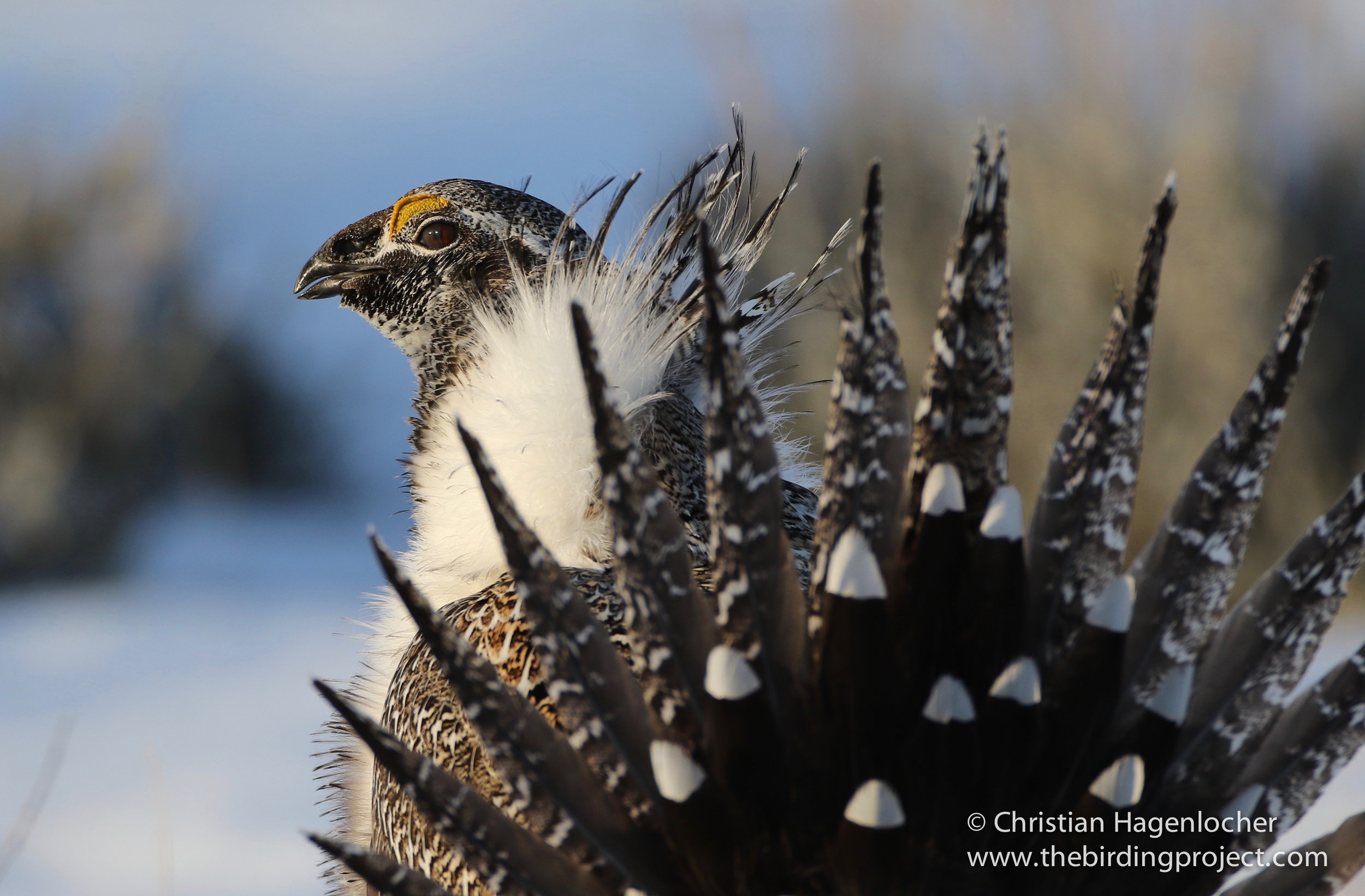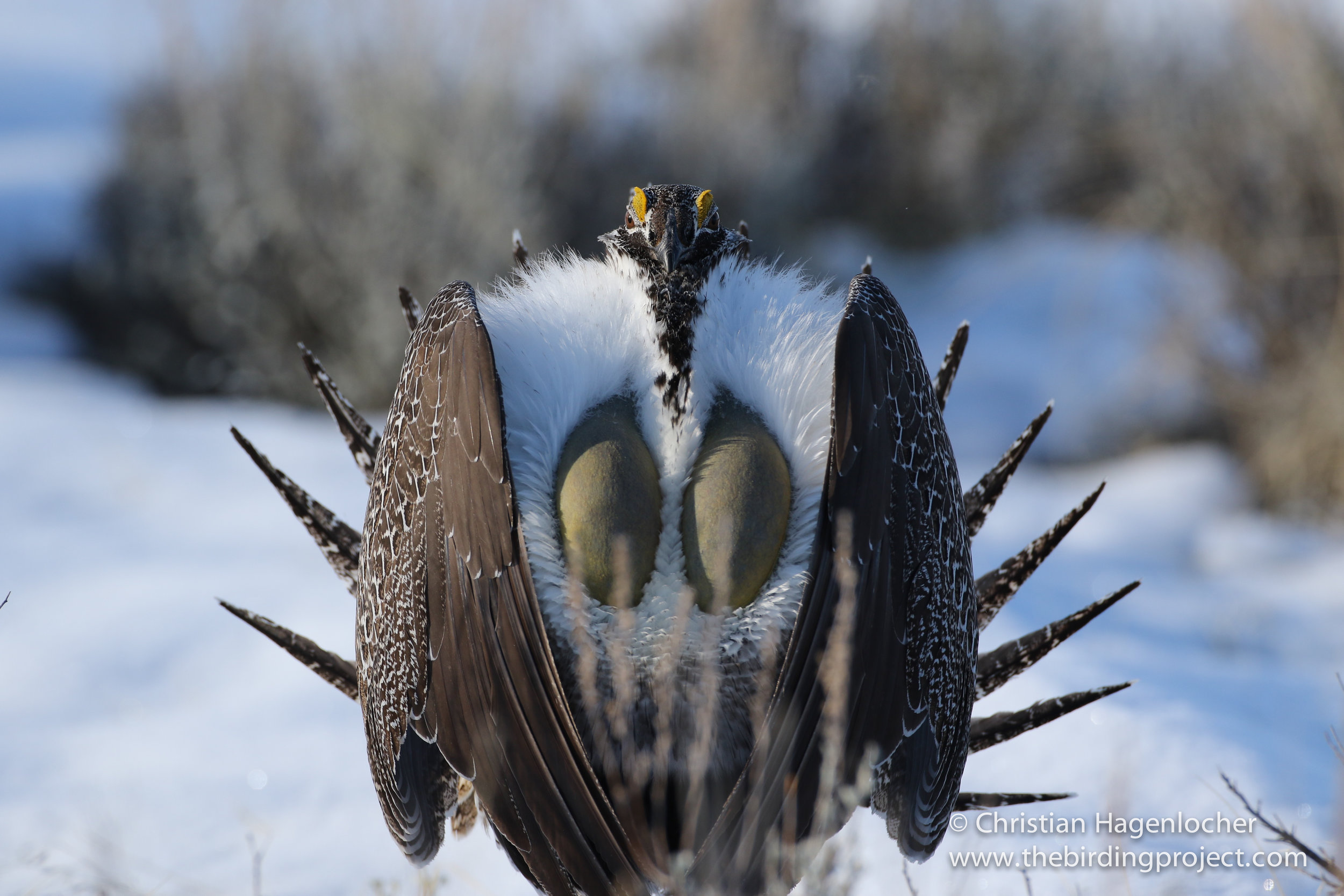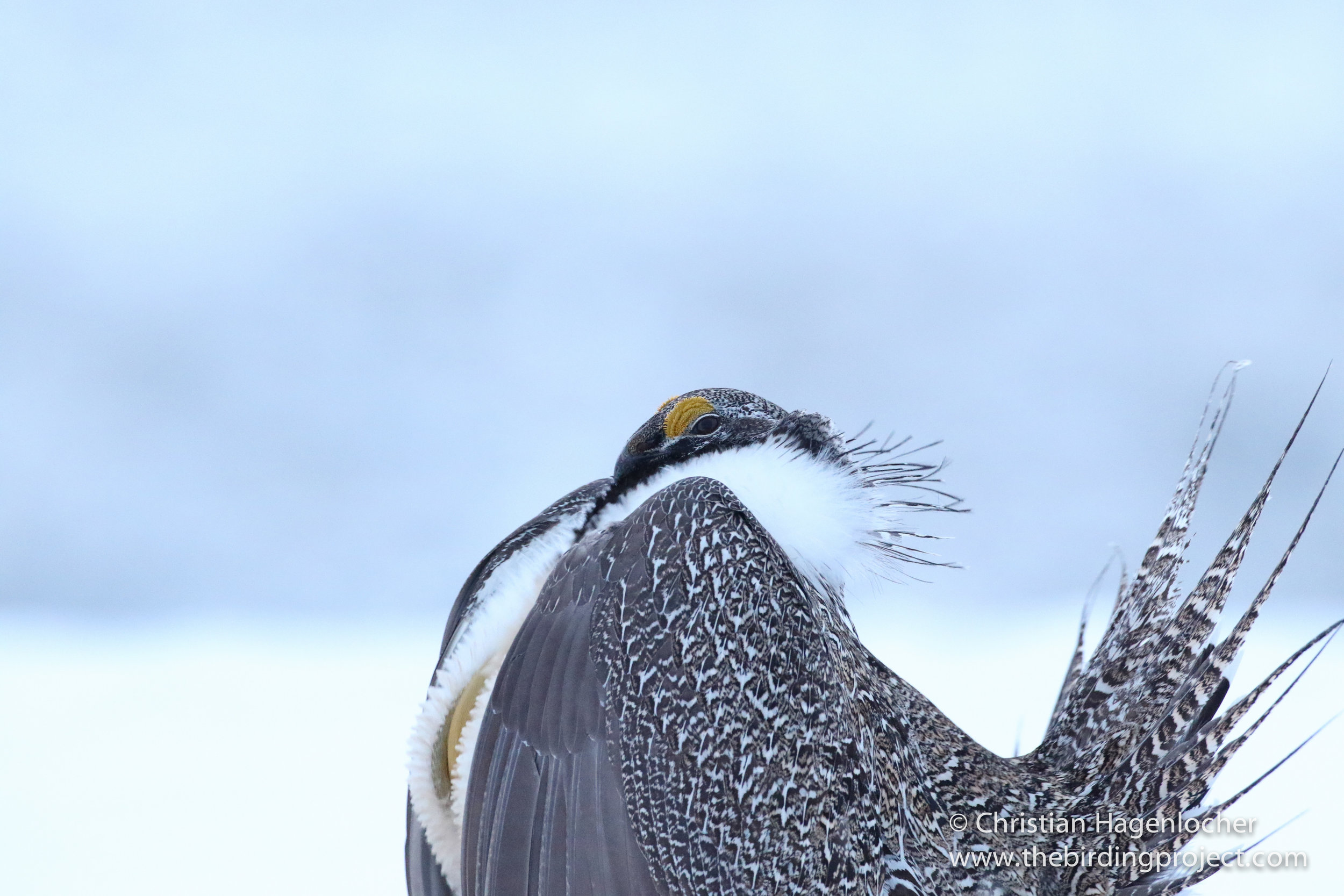The Greater Sage Grouse
Few wildlife encounters have an impact so profound on one's experience as seeing Greater Sage-Grouse in the Spring. Those who have witnessed their ancient rituals can attest, it is truly one of the most beautiful and charismatic mating displays on the continent. Every Spring, males of the species gather on traditional breeding grounds called "leks" to fight other males and display for the visiting females, who conservatively huddle together like girls at a middle school dance. Several dominant males with bobbing neck plumes and long spiky tail feathers will acoustically assert their dominance, and end up mating with multiple females. The paired vocal sacs of the males (actually extensions of the esophagus) are inflated with air, and sound is directionally projected outwards to the observant females.
The existence of Sage-Grouse is woven tightly into the fabric of the Sagebrush Sea ecosystem. This treeless expanse of sagebrush shrublands rolls over hills, plains, and creeps up mountain steppes across the western United States. Having hundreds of uninterrupted acres of habitat allows not only grouse to thrive, but other species as well. The Greater Sage-Grouse is a prime example of a "umbrella species" -- a bird requiring large, uninterrupted expanses of habitat so that conserving Sage-Grouse indirectly protects and benefits a large variety of other plants, animals, and bird species. Sadly, this habitat is changing rapidly due to oil and gas development.
Sunrise over the Sagebrush Sea. You can see the open snow-blanketed Sage-Grouse lek in the middle of the image.
One of the most memorable experiences of my Big Year (there were many) was driving through Colorado and Wyoming, searching for Sage-Grouse. I was unsuccessful in finding Gunnison Sage-Grouse in Colorado early last March, and made the drive up to Wyoming with hopes of seeing Greater Sage-Grouse, and meeting the Maven Guys. Yet the magic didn't happen until early one morning, outside of Lander, Wyoming in mid-March. It was an incredible experience that I can't wait to publish in my book! I'd love to share some images and background of what I learned from the multiple mornings I spent in Wyoming with the Greater Sage-Grouse- an incredible species.
Nesting
I learned from the Sage Grouse Initiative that ideally leks are close to nesting habitat. The hens seek out sagebrush that is between 1-3 feet high, creating their nest under the most dominant sage plant in the cluster. Camouflage is essential to survival- if the nest can remain hidden, then the clutch has a higher chance of succeeding. Often, dense grasses help shield the nest from the keen eyes of ravens and coyotes- eager predators to make a meal of sage grouse eggs.
When the chicks hatch in mid May, the precocial young hatch with open eyes and are covered with quick-drying downy feathers. They require lots of food, and the greater diversity of plant life surrounding the young birds, the greater the diversity of insects. According to an Oregon study on Sage-Grouse chicks, their diet was composed of 34 genera of forbs and 41 families of invertebrates, which a preference for ants and beetles.
Sage-Grouse Migration
Many upland game birds are assumed to be non-migratory, but researchers have found some Sage-Grouse migrate up to 100 miles away from their home territory to a lekking area. Read more about this amazing migration. The key to this long-distance movement is having parcels of sagebrush habitat to travel through- a corridor of connected, high-quality habitat for food and cover. If this path is interrupted by highways, open farm fields, and power lines, their travel corridor is blocked, and long-distance movements become more restricted.
The People Behind the Success
Stan, from the Wyoming Department of Fish and Game spent some time with me helping me understand the conservation issues surrounding Greater Sage-Grouse in Wyoming.
These reasons are why conserving Sage-Grouse habitat requires big-picture thinking, and managing landscapes to keep sagebrush habitats intact. This requires cooperation between private and public land managers, who in acting in the interest of wildlife and ranching, can use holistic management to benefit everyone.
There's so much to write about Sage-Grouse. I have lots to share: interviews with Sage-Grouse Biologists, GIS Analysts, interns, PhD's, and hunters. There's simply not enough room on a blog!
Women in Science
Recently there's been a huge influx on social media highlighting female scientists, and sharing what they do and contribute to their fields. It's been inspirational to see my friends, colleagues, and women I admire sharing on Twitter, Instagram, etc. I'd like to take a moment and highlight two women who are both supporting the Science community in understanding how Sage-Grouse interact with their environment, and through their work helping us all understand and protect this important species.
Nyssa works for the Wyoming Game and Fish Department as the Sage-Grouse GIS Analyst. I was excited to interview her and ask her about the role technology plays in bird conservation through her line of work. Here is a short excerpt from our interview:
How did you get a job working with technology and wildlife?
I was living in D.C. and not really enjoying it. This position for Sage Grouse GIS Analyst opened up. GIS is my background, I don’t have any biology background. I thought that sounds fun, I’ll move to Wyoming. I packed my car and drove out here.
Nyssa was asked by the Wyoming Governor to provide data on the prime Sage-Grouse habitat in the state. "We used just a handful of data sets which looked at oil and natural gas, lek density breeding analysis which looked at the lek populations and the amount of birds on the leks to show where the densest portions of the populations were." She and her team were able to provide high-quality data that led to swift management decisions ruling in favor of protecting Sage-Grouse. Great work, Nyssa!
Research with Robots?
While in Wyoming, I met Dr. Gail Patricelli from the University of California Davis. She and her team of biologists are studying Sage-Grouse behavior, through social interactions between male Sage-Grouse and a female robot. Using a R/C controller from a nearby blind, she can "flirt" with the male Sage-Grouse by raising and lowering the females head, and animating the bird to nearly replicate many of the innuendoes of the real thing. Gail took time out of her day to show me how the robots were constructed (see photo to the right) and what they look like once a Sage-Grouse skin is mounted on them. Once fully-built, the birds look super-convincing to a casual observer. Her team of undergrads is hard at work in the sagebrush sea each morning during mating season, keeping a close eye on every individual, recording mating events, and identifying the responsible males by the unique pattern of their undertail coverts. What an innovate idea, providing some way-cool insights into the mating behaviors of this unique species!
During the lekking season, male Sage-Grouse are driven by hormones, not brain cells. They have been observed mating with cow pies, (that male is affectionately called "Cow Pie") so running a radio-controlled decoy around on the leks is not reducing the chance of real mating going on, and is contributing valuable data to the social interactions between male and female birds on the lek- something that has been rarely studied before.










